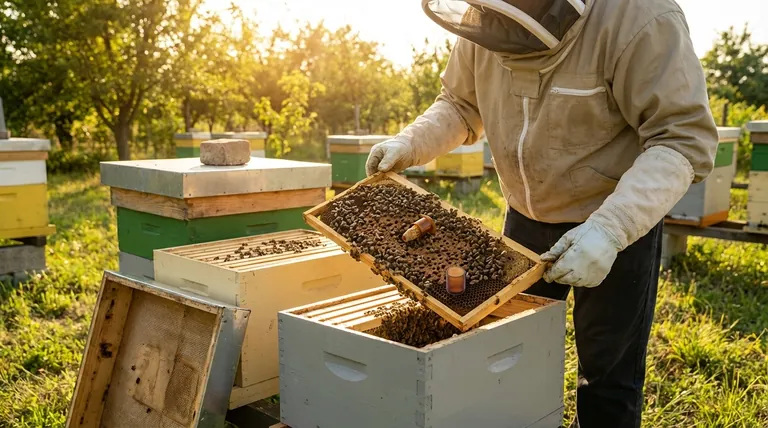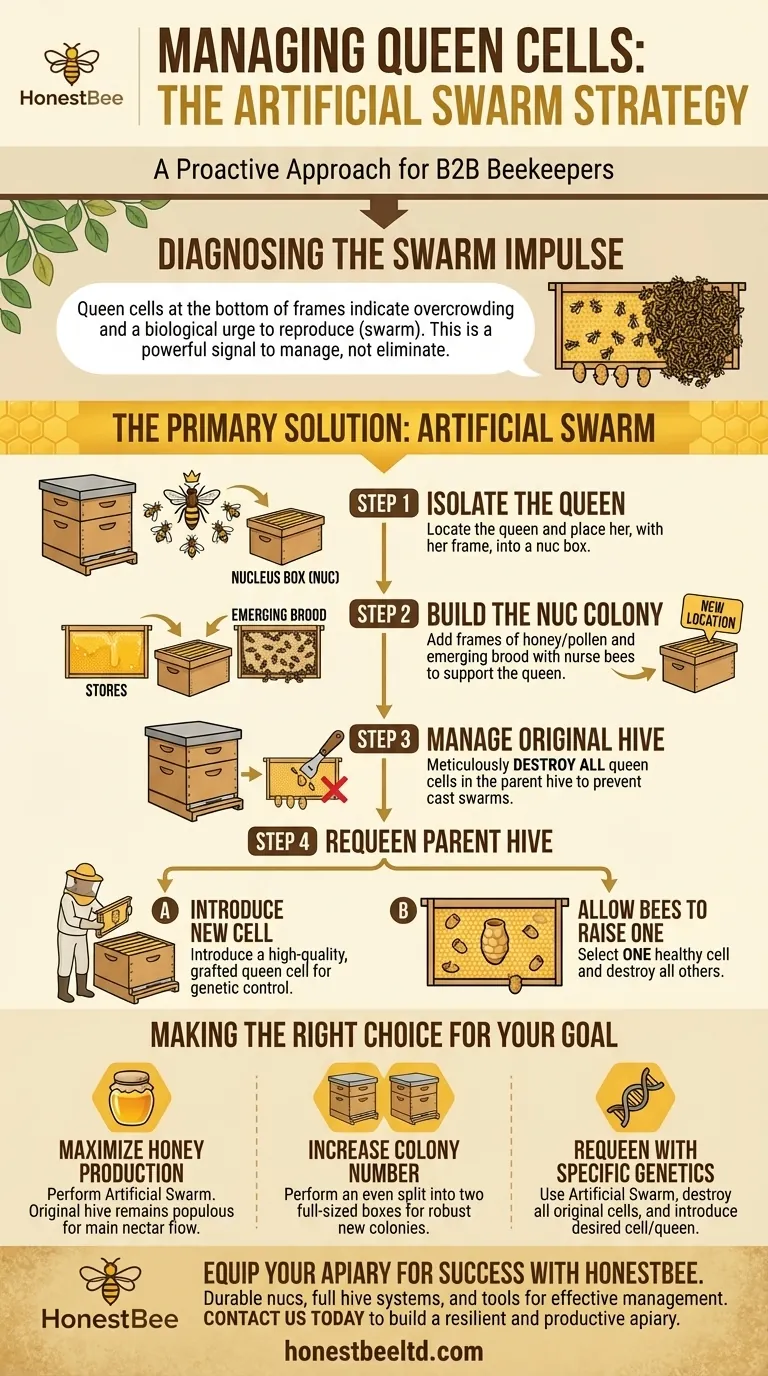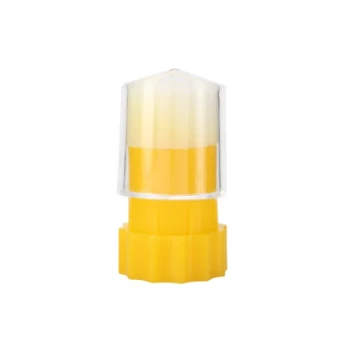When you find queen cells in the bottom box of a hive, your immediate course of action is to perform an "artificial swarm." This involves moving the current queen into a separate, smaller hive (a nucleus box) along with a few frames of bees and brood, and then systematically managing the queen cells left behind in the original, now queenless, colony.
Discovering queen cells is not a problem to be eliminated, but a powerful biological signal to be managed. Your goal is to intervene in the colony's natural swarm impulse to prevent losing half your bees while retaining control over your apiary's health and productivity.

Diagnosing the Situation: Why Queen Cells Appear
Before taking action, it's crucial to understand what the bees are telling you. The presence of queen cells, especially along the bottom of the frames in a strong colony, is a definitive sign of the swarm impulse.
The Core Driver: The Swarm Impulse
The colony has likely become crowded. The queen is running out of space to lay eggs, and the population is booming.
From the colony's perspective, this is a sign of success. They have the resources and population to reproduce by splitting into two separate colonies—a process we call swarming.
Verifying the Queen's Presence
Your very first step during the inspection is to find the queen.
If you find her, you can proactively manage the situation. If you cannot find her and the queen cells are capped, it is possible the hive has already swarmed. In that case, your management strategy will shift to ensuring the remaining colony successfully raises a new, well-mated queen.
The Primary Strategy: The Artificial Swarm
An artificial swarm is the beekeeper's method of mimicking a natural swarm on their own terms. It relieves the colony's impulse to leave and gives you two colonies instead of one.
Step 1: Isolate the Queen
Carefully locate the queen. Once found, place her and the frame she is on into a nucleus box (nuc).
A nuc is simply a small hive box, typically holding three to five frames.
Step 2: Build the Nucleus Colony
To support the queen in her new home, add a frame of honey and pollen (stores) and another frame of emerging brood with its attached nurse bees to the nuc.
This gives her a small, dedicated workforce and the resources to begin laying immediately. Move this new nuc to a different location in your apiary.
Step 3: Manage the Original Hive
Return to the original hive, which is now queenless but still powerful and full of bees. You must go through every single frame and destroy all queen cells.
Be meticulous. Missing even one cell can lead to the colony sending out secondary "cast swarms" with virgin queens, further depleting its population.
Step 4: Requeen the Parent Hive
You now have two options for the queenless parent hive:
- Introduce a New Cell: If you are raising your own queens, you can introduce a high-quality, grafted queen cell. This gives you genetic control.
- Allow the Bees to Raise One: Alternatively, you can select one large, healthy-looking queen cell (shaped like a peanut) and destroy all others. The colony will then raise this single queen as its new monarch.
Understanding the Trade-offs
Simply knocking down queen cells without addressing the underlying swarm impulse is rarely effective. The bees will almost certainly build more.
The Risk of Inaction
If you do nothing, the colony will swarm. You will lose your old queen and approximately half of your bees. This significantly reduces the hive's honey production potential for the season.
The Risk of Incomplete Action
If you perform an artificial swarm but miss a queen cell in the parent hive, you risk a cast swarm. Thoroughness is the key to success. The goal is to leave the bees with only one clear path to raising a single new queen.
Making the Right Choice for Your Goal
Your response to finding queen cells depends entirely on what you want to achieve with your colonies.
- If your primary focus is maximizing honey production: Perform the artificial swarm as described. The original hive remains populous and, once its new queen is mated and laying, will have a powerful foraging force ready for the main nectar flow.
- If your primary focus is increasing your number of colonies: You can perform an even split instead of a small nuc. Divide the brood and resource frames more equally between two full-sized boxes to create two robust colonies.
- If your primary focus is requeening with specific genetics: Use the artificial swarm method, but be certain to destroy all original queen cells and introduce a cell or a new mated queen of your choosing into the parent hive.
By understanding the bees' intent, you can work with their natural instincts to build a stronger, more productive apiary.
Summary Table:
| Action Step | Key Purpose |
|---|---|
| Isolate the Queen | Remove the primary driver of the swarm impulse. |
| Build a Nucleus Colony | Create a safe, new home for the queen with resources. |
| Destroy All Queen Cells | Prevent cast swarms and maintain control. |
| Requeen the Parent Hive | Ensure a strong, mated queen leads the original colony. |
Ready to manage your hives with confidence and precision?
As a commercial beekeeper or distributor, preventing swarms is critical for protecting your investment and maximizing honey production. HONESTBEE supplies the durable, high-quality beekeeping equipment—from nucleus boxes to full hive systems—that you need to execute management strategies like the artificial swarm effectively.
Let our wholesale-focused expertise help you build a more resilient and productive apiary. Contact our team today to discuss your specific needs and explore our product catalog.
Visual Guide

Related Products
- Brown Nicot Queen Cell Cups for Breeding Queen Bees Beekeeping
- JZBZ Push-In Queen Cell Cups for Beekeeping
- JZBZ Type Wide Base Plastic Queen Cell Cups for Base Mounting and Queen Rearing
- Clear Black Plain Polystyrene Queen Bee Grafting Cell Cups No Lug for Bee Queen Cup
- JZBZ Langstroth Queen Rearing Frame for Beekeeping
People Also Ask
- What should be done with extra queens from grafting? A Strategic Guide for Apiary Management
- Why is it important to select a healthy larva less than 24 hours old for queen rearing? Maximize Queen Quality and Colony Strength
- What is the advantage of the Nicot Cupkit system? Secure Your Queen Rearing Success with Batch Protection
- What are the ideal conditions for raising good queen cells? Achieve Robust Queens with Strong Cell-Builder Colonies
- What are the signs that a queen cell is about to emerge? Master the Critical Timing for Hive Success











